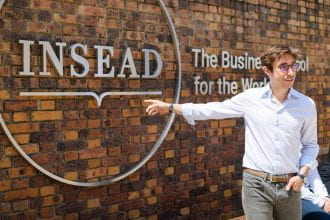INSEAD Professor Nathan Furr is on a mission to harness innovation to solve critical problems

Assistant Professor of Strategy Nathan Furr has always felt drawn to the topic of innovation. But it wasn’t until he observed a course on innovation while teaching at Stanford University that he began to realise its true potential to solve global problems.
The course tasked students with finding a way to prevent the deaths of premature infants who cannot regulate their body temperature—a common tragedy in developing countries due to limited access to incubators. One team impressed Furr by tackling the problem in a fundamentally new way: They created a pouch of wax that could be tossed into a pot of boiling water and then inserted into a tiny sleeping bag to keep a baby warm. The product cost 1/500th of what an incubator cost and could be used anywhere, by anyone.
“At that moment, I realised innovation is fundamentally about solving problems, and I wanted to spend my life figuring out how to do that,” Furr remembers. “Sometimes those problems are big and visible, like infants dying prematurely, and sometimes they are less visible, like creating jobs and making the most of people’s talents. But we should aspire to solving the world’s problems, and innovation is the tool to do it.”
We should aspire to solving the world’s problems, and innovation is the tool to do it.
An engine for good
A recognised expert in innovation, technology strategy, entrepreneurship and value creation, Furr focuses his research on how both new and established firms adapt to changes in technology and enter new markets. At INSEAD, he teaches technology strategy to MBA students and digital transformation and innovation to executives.
“I cover a lot of territory, but to me it is all integrated,” says Furr, who holds BA, MA and MBA degrees from Brigham Young University and a PhD from Stanford University. “I explore the what and how of innovation and change in a technology-driven world.”
In the INSEAD classroom, he tries to get students excited about the possibilities of change and learn how to adapt quickly in an ever-evolving world. He also encourages them to think about innovation in the context of INSEAD’s mission to advance business as a force for good.
“Innovation is the engine of doing good in the world,” he says. “My life’s mission is to understand how to do it well so we can better solve the problems around us.”
Technology, he adds, can either advance or impede progress toward this goal. “Technology is accelerating the possibilities in the world, but also increasing the inequalities,” he says. “It has brought down barriers for more people to create, interact and communicate, but it has also created a great deal of harm. How we use technology is what determines the difference in outcomes.”
Endlessly curious
Innovation isn’t something that Furr studies from a distance. He actively integrates it into his work as a professor, researcher and author. A catalyst for ideas, Furr is eager to study new concepts in innovation as they emerge and communicate what he finds through teaching and publishing.
“What excites me is the virtuous cycle of getting out there, sharing an idea and then having someone ask me a question that we don’t have an answer for, which inspires another round of discovery and broadcasting,” he shares.
Furr has turned his research into numerous articles and bestselling books, including The Innovator’s Method: Bringing the Lean Start-up into Your Organization and Nail It then Scale It: The Entrepreneur’s Guide to Creating and Managing Breakthrough Innovation. His latest book, Leading Transformation: How to Take Charge of Your Company’s Future, outlines a three-step process to create breakthrough change by envisioning the possible, breaking down resistance and prototyping the future. It helps business leaders overcome and transcend “the intractable human problems” associated with change, including fear, habits and routines, politics and the inability to see what doesn’t yet exist.
“We asked if we could apply the last few decades of behavioural science to design some tools and use them in companies to test if they work—and they did!” Furr shares. “So we wrote the book to inspire people about what is possible in leading change.”
Furr’s next book, Innovation Capital, discusses how to get buy-in for your ideas and will be published by Harvard Business Review Press this June. He’s also outlining a book called Six Laws of Technology that will synthesise his teaching and research on technology strategy to provide tools for leaders to make smart choices.
With many other publications also in the planning stages, Furr is passionate about his area of expertise and never at a loss for ideas. “I’m endlessly curious,” he says. “I only wish I had more time.”


